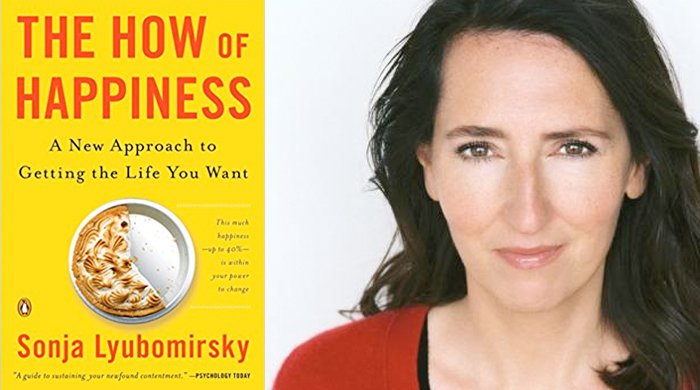If you only read one happiness book, let this be the one. Written by a serious psychological researcher, “The How of Happiness” eschews the usual laundry list of quick fixes and instead offers a unified theory of sustainable happiness, backed by empirical evidence and sound reasoning.
Beyond the research, Lyubomirsky offers important reassurance that working to increase one’s happiness is a vital, momentous endeavor. Happiness, as she defines it, is no shallow pursuit. Rather, it’s the intentional construction of “the experience of joy, contentment or positive well-being, combined with a sense that one’s life is good, meaningful and worthwhile.” And its benefits are many. Happy people are more energetic, sociable, charitable and healthy. They live longer, work smarter and lead better.
We should scarcely need to be reminded of joy’s virtues when hopelessness and despondency are so prevalent in our society. Major depression is the leading cause of disability for 15- to 44-year-olds in this country, according to the CDC. And many more people who aren’t clinically depressed fall short of experiencing the happiness in life that’s available to them, hurt by unrealistic personal expectations, weighty feelings of self-blame and diminished social support.
Openly advocating for happiness–our own and others’–is important work. And Lyubormirsky compiles extensive research to show that increasing feelings of well-being is within our grasp. Intentional daily activity–happiness work, if you will–can make a difference. “If we observe genuinely happy people, we shall find that they do not just sit around being contented,” she writes. “They make things happen. They pursue new understandings, seek new achievements, and control their thoughts and feelings.”
A Customized Approach
The book’s conscientious scientific perspective and straightforward advice can feel a bit too tidy and clinical in places, but what it lacks in emotional power and messy personal narrative, it makes up for in practicality and effectiveness. It offers powerful assessment tools: happiness scale, person-activity fit diagnostics and happiness questionnaire. Together, they help readers assess their current happiness level and fashion individualized happiness programs. Thus equipped, committed glee seekers can animate the science and create their own personal stories of joyful living.
This customization is key. While most self-help books throw out a slew of one-size-fits-all suggestions, Lyubomirsky cites research revealing that individuals benefit from some strategies more than others based on their own unique needs, interests, values, resources and inclinations. Moreover, the book includes a self-diagnostic test that systematically determines which of 12 “happiness activities” would be most valuable for the reader.
Fit is key: “…if there’s any ‘secret’ to becoming happier, the secret is in establishing which happiness strategies suit you best,” she writes. “One of the chief reasons that many of us fail in our efforts to become happier is unfortunate choosing, picking a strategy or approach that is either inherently fruitless (like pursuing wealth, approval, or beauty…) or not well suited to us.”
Circumstance changes don’t boost happiness long term because humans adapt to the improvements so quickly, she explains. The raise, the bigger house, the new car quickly become a new normal and no longer boost happiness. Moreover, such changes can’t create sustained happiness for many people because they are impractical — impossible often — to obtain in the first place. “Does everyone have the money, resources, or time to change her living situation, her job, her spouse, her physical appearance?” she asks.
Click to Tweet: “…if there’s any ‘secret’ to becoming happier, the secret is in establishing which happiness strategies suit you best.”
Takeaways
I loved the person-activity fit diagnostic because it helped me break out of the shoulds and ought-tos to discern what’s actually likely to help me increase happiness. Happiness, I learned, is (like everything else in life) built on selectivity. As Arthur Ashe wrote, “Don’t try to do everything. Choose carefully, and then give your all to what you choose.” In essence, the results gave me permission to do more of what I love–getting into a state of flow through engaging activities like reading and writing–and less of activities that don’t come as naturally to me. Choosing the wrong “happiness activity” or implementing the right one the wrong way can doom the whole enterprise.
“The How of Happiness” offers 12 of these happiness activities, none of which is earth shattering on its surface. But the book stands out for its systematic process to select which will work for you, explanation of why they work and nitty gritty descriptions of exactly how (and how often) to implement the practices. For example, she explains that expressing gratitude boosts happiness by promoting the savoring of positive life experiences, building self-worth and self-esteem, helping people cope with stress, encouraging moral behavior, building social bonds and more. Then she offers several ideas for practicing gratitude and urges readers who resonate with the practice to select just one — say, writing in a gratitude journal — and then vary how they implement it. So, rather than journaling daily about what you are grateful for, which could become a chore and minimize the benefits, she suggests expressing gratitude after particular triggers, such as enduring a hardship. This call to variety is grounded in research, as are the strategies and supporting practices, which bolsters confidence that it will actually work.
It’s too soon for me to know if the happiness boosts I’ve experienced from reading the book and implementing its tailored suggestions will last long-term. But consider this review to be my heartfelt expression of gratitude to Lyubormirsky for providing much-needed perspective on the whys–and hows–of happiness. The revelation that we’re conditioned to believe the wrong things (money, recognition, appearance, etc.) will make us lastingly happy was alone worth the jacket price.


